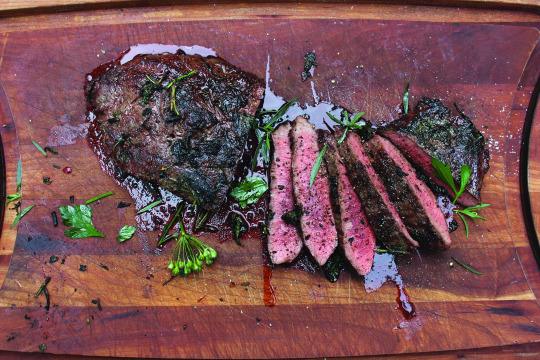Rob Firing is Canada’s first cookbook agent. He has put together deals for cookbooks by an impressive roster of great chefs, and this spring he will launch his very own. A book devoted to steak, (which includes a recipe by the Drake’s own Ben Bergeron), the appropriately titled Steak Revolution will be published by HarperCollins this month. Join us at the launch party on April 30th.

Tell me a little bit about yourself.
Like many steak enthusiasts, the memory of my first steak goes way back to childhood. A lot has happened since then: various stints working at steak restaurants, many subsequent years of continuing to enjoy steak immensely, more years working with amazing chefs and cookbook authors (like the wonderful Jamie Oliver, the charming Ricardo L’Arrivee, the intrepid Anthony Bourdain, the magical Laura Calder and the unstoppable Jamie Kennedy) who had books with steak in them. Then as many steak dinners as I could fit in at Les Halles (R.I.P.) when I lived in Manhattan, even more in my amazing hometown Toronto, and onward to many different steaks cooked many different ways in many different places. Eventually, I got married (to a beguiling vegetarian), and now I’m a food-oriented author and a literary agent specializing in food and cookery.
What made you decide to spend two years of your life writing and researching a book about steak?
Besides the clear obsession, I came to understand that steak is sometimes profoundly misunderstood. Some are anxious about screwing up a nice steak, others are hung up on weird steak myths, and then there is politics. I thought it might be a good idea to try to set the record straight, and end up with a nice cookbook at the same time. You don’t see too many cookery books out there just about beef steak, and this is certainly the first one HarperCollins has published. The germ of the idea came to me two years ago, while I was walking along Bloor Street, wondering if I would ever write another cookbook. I passed by a butcher shop and looked in the window at a nicely aged rack of prime and I heard a voice. A strange muse, to be sure, but I listened, and here I am.

What is the number one misconception that people have about red meat?
Just one? Here are three! (and this is by no means a compete list):
1. Red meat is bad for you. — It’s actually incredibly nutritious, as most meat is, and the red stuff itself is merely extra iron bonded to myoglobin (with oxygen), a protein that lets the muscle work harder in the live animal.
2. Red meat is harder on the environment than other meats (and fish). — This is only sometimes true, when cattle farming practices are industrialized or badly managed. Managed properly, cows provide environmental services–more than most of us realize–and are a potentially a much lower-input, lighter-footprint farm animal than pigs or chickens.
3. There are too many cows on the planet. — Are there? They number about 1.3 billion, which seems like a lot. But this is a mere flicker of the number of enormous grazers that roamed the grasslands – that helped create, maintain and co-evolved with the grassland biome for 50 million years – before we humans killed them all in just the last 15,000 years or so. Before humans hunted in earnest, the earth was home to many more billions of large animals. In a way, the cow is their only living proxy in terms of numbers. All the more reason to try to better understand them, and to raise them in a way that mimics how they used to live, before we came along, as closely as possible (which a growing number of enlightened ranchers do).
You’ve included a recipe from a Drake chef in the book, specifically the grainy mustard developed by Drake commissary’s Ben Bergeron. How did that come about?
One afternoon at lunch at the Drake Commissary with my friend and frequent co-conspirator Ivy Knight, I tucked into a sublime brisket. I coated my second bite with a fair amount of this wonderfully textured grainy mustard, served on the side. Full disclosure: I already love mustard, and appreciate it when special care is paid to this emperor of condiments. But this was something altogether different. Ivy seemed startled, then laughed as my eyes widened to the size of dinner plates as the reality of a dozen perceptible yet perfectly balanced flavours competed for (and received) my appreciation. I said only: “I need to get this,” and Chef Ben, at Ivy’s behest, very kindly donated his recipe for my book. He uses Henderson’s beer from the brewery next door, and it takes a full 60 days for the mustard to ripen. Another full disclosure: I snuck off to my fridge and had a spoonful of the stuff between typing the last sentence and this one. Impossible not to.

How many recipes can a cookbook about steak have – how many ways can one cook a steak?
The thing about steak is there are many different sorts, with different kinds of meat that behave differently and take better to one sort of cooking approach or another. Some steaks are tender while others are tasty, and less tender, and then there are so many textures and other qualities. Each cut benefits from specific cooking (and carving and serving) strategies that take advantage of their good qualities while taking care of their trickier aspects. Do I cook over fire or coal or gas flame? Should I fry this particular steak or should I reverse-sear this other? Since I focus on the butchers’ cuts as much as the better-known cuts, this becomes even more important (and more fun!), and there is much to be said about how and why a steak turns out just right. Besides this, I’ve included some terrific, steak-friendly sides and salads, and even desserts and highly appropriate cocktails, so that your dinner guests will not only praise you for your super powers, but will remember you for the rest of their lives.

